Japan: A travel tale from hell on a journey too short
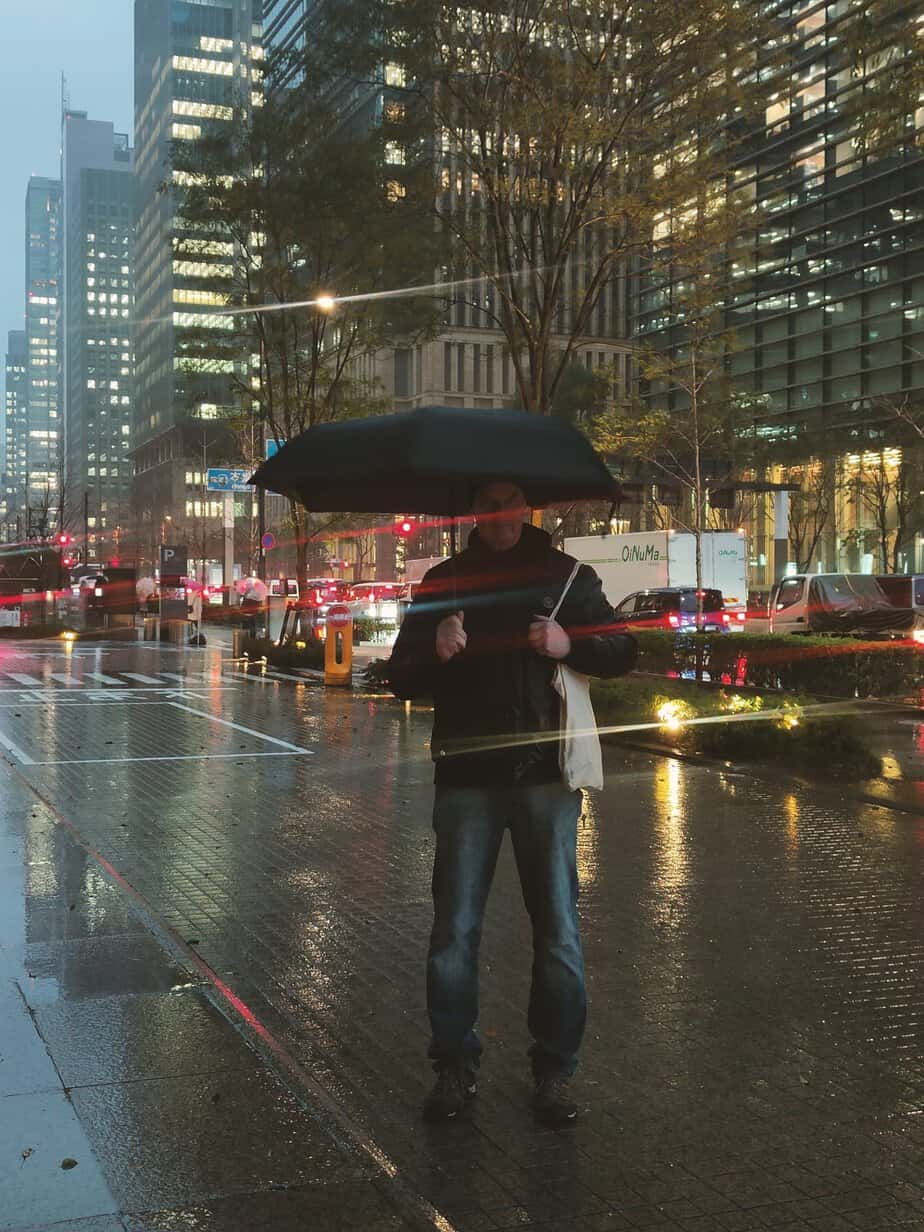
(This is the first of a series of blogs on Japan and Shanghai.)
TOKYO – I had shaken off 30 minutes of rain from my umbrella as I plodded up the narrow staircase in my soggy shoes. Tokyo is rife with narrow staircases, high elevators and endless escalators that seem to crisscross like a sudoku puzzle.
Tokyo is as vertical as a giant concrete and glass picket fence. I was an anonymous speck in a tiny high-rise office asking a young, smiling attendant for a doctor – between massive hacks of a killer cough. She waved both her hands at me, not to stop me from giving her what sounded like advanced Covid but to say she couldn’t help me.
Still beaming, almost apologetically, she held up a small piece of paper that read, in English, “I’m sorry. We can’t see patients who don’t speak Japanese. Safety regulations.”
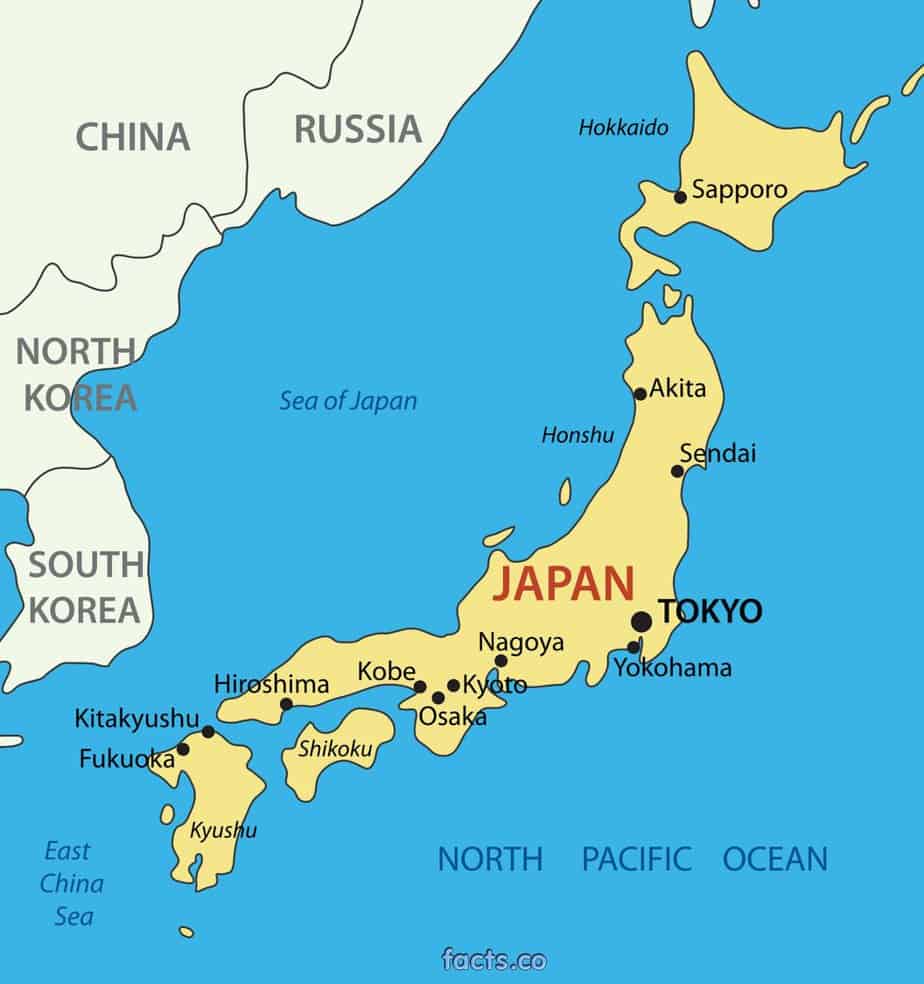
Not beaming, I poured myself down the staircase into rivulets of water pouring through Tokyo. I coughed. Again.
I was trying to see the world’s largest city in 24 hours, one of my more savvy travel decisions. Compounding the moronic venture, I spent half the day looking for medical help.
Marina and I were on our way to Kyoto to celebrate my birthday Friday amongst Japan’s famous springtime cherry blossoms. We were in a hurry. We had only a week. Traveling halfway around the world and spending only a week is not a trip. It’s a tease. But Marina has elderly parents and an indoor-outdoor cat, all of whom I adore. I relented to her one-week limit.
What we didn’t count on was me getting sick before my first bite of raw fish.
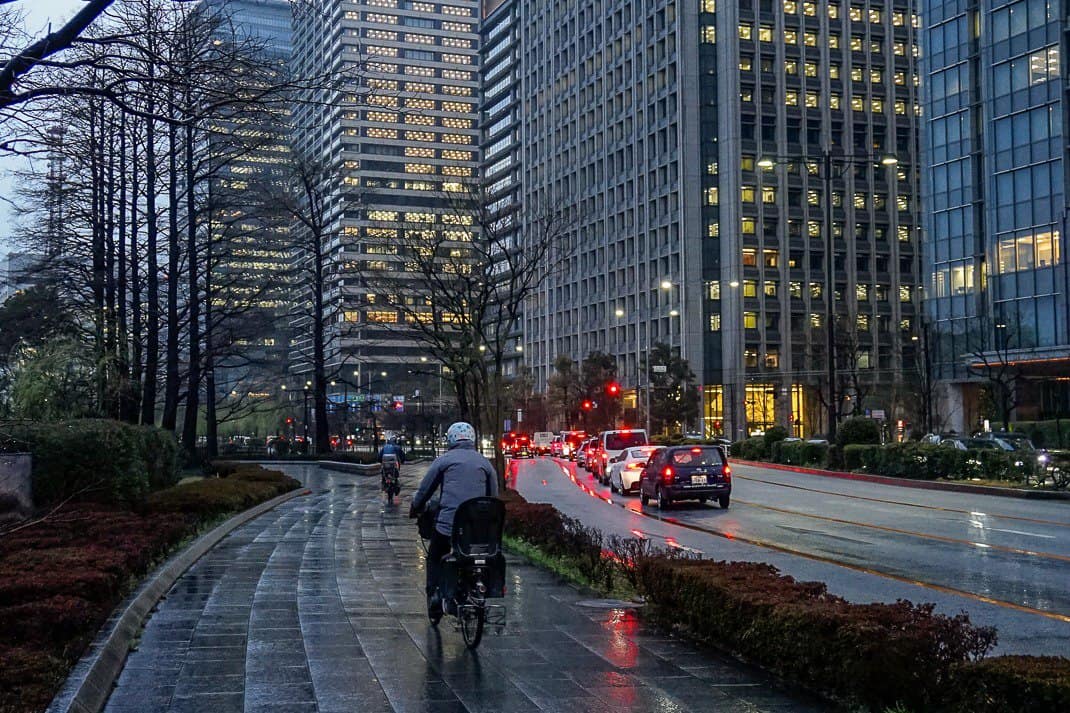
The journey to Japan
The cough began back home in Rome the day before our flight. I had a slight cough that was nothing more than an occasional hiccup. We boarded a China Eastern jet for a jam-packed 11-hour flight to Shanghai then a three-hour flight to Tokyo. I coughed up one lung somewhere over Siberia.
By the time we landed in Haneda Airport at 9 the next night, my cough had turned into a full-scale bellow. Loud and relentless, I coughed so much my chest and back hurt. Soon my head began to pound.
The biggest thing I hate about flying is the FAA regulation that for years required every screaming child under the age of 5 to sit within one row of John Henderson.
On that trip to Tokyo, I was that screaming child.
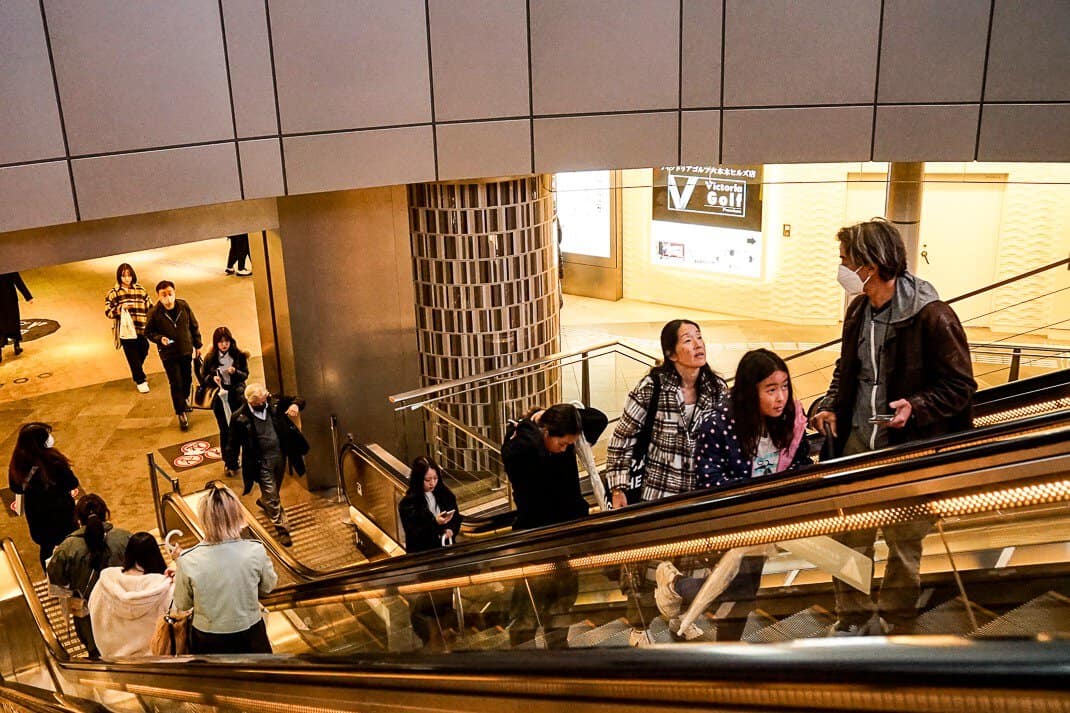
Worse, Tokyo could not have been less welcoming if the immigration official taking my passport was Godzilla. The weather was horrific. Pouring rain. Wicked wind. Temperature in the high 40s. On our cab ride to our hotel we saw Tokyo’s trademark mix of neon signage and the bottom half of skyscrapers through a thick cover of rain.
I felt like we were on the set of Blade Runner.
Our Hotel Pride Akasaka Kokkaigijidomae was as hard to like as it was to pronounce. Part of Japan’s APA hotel chain, the Pride’s room was just big enough for one of Japan’s trademark undersized beds and a small bathroom. It didn’t even have a closet.
The hotel construction won’t land it on the cover of Japanese Architecture Quarterly, either. The external hallways were stacked above an atrium as cold as outside. When we left our eighth-floor room, we had to fight the elements to the elevator. In the summer, I imagine you sweated in Tokyo’s famous 75-percent humidity. Last week, I had to don my parker, scarf and hat just to go to the lobby.

But at least the woman at the front desk said they had a bar. Marina and I could still have our ceremonial welcome beer. I needed one. We went to the 17th floor to what I assumed would be a relaxing lounge with overstuffed couches looking out onto other high rises.
The Hotel Pride’s bar was two vending machines selling canned beer so anonymously industrial, it had no name in English. It read, “Brewed For Good Taste.”
Welcome to the Land Where the Sun Didn’t Rise.
Searching for a doctor
We woke the next morning late, hopelessly missing breakfast. Any jet lag lost was replaced by my cough that had escalated to the point where coughing became easier than speaking. I began communicating with Marina, a Rome native, with Italian hand gestures.
I was not planning to open my trip to Japan by jumping into the Japanese healthcare system. Fortunately, it’s fairer than the United States’. Then again, so is much of sub-Saharan Africa. Japanese salaries feed into the national health insurance and residents pay the other 30 percent of the costs. As in Italy, I knew getting cured would not break my budget.
My hotel gave me a list of doctors and pharmacies in the area. Our neighborhood of Akasaka was just south of the famed shopping district of Roppongi and void of tourist attractions. Akasaka was built for locals.

We puddle jumped our way across huge boulevards under overpasses and past cheap retail stores and hole-in-the-wall restaurants. I took note of none of them. I needed pills, not sushi.
Our first stop was a ground-floor office where I mumbled, “I need a doctor for a bad cough.” The woman understood English but couldn’t speak it. To answer, she rubbed her face and pointed to products lining the wall. It was a dermatologist’s office.
She gave us the name of the English-banned office that sent us on our way with the name of a doctor who spoke English. The office would close at 12:30 p.m. We had 15 minutes. We raced down the street and around the corner, waving our umbrellas like samurais. We took an elevator a few floors where at 12:25 p.m. the clerk told us yes, the doctor speaks English. But we need to book an appointment. When was the doctor’s next opening?
In two months.
Emerging from the office came the doctor, a smiling, middle-aged woman with a big mop of curly black hair and a long, formless dress. She suggested I get specific medicine and wrote my symptoms in Japanese characters so neat it looked like calligraphy.
Our GPS failed us and we asked two burly cops, between my hacks, where a certain pharmacy would be. We wound up in the Akamaka subway station staring at one of Tokyo’s at least 1.5 million 7-Elevens. Japanese 7-Elevens even sell medicine?
No, but next door at a pharmacy, I gave the young clerk my soggy message. She pointed out a box of pills which I bought without hesitation or questions despite not a single English word visible. But before leaving I had to answer four questions from a piece of paper the woman held up in English.
Who is the medicine for? (I pointed to myself.)
What is the medicine for? (I coughed. Again.)
Have I ever used the product? (I shook my head.)
Do I have any other concerns? (Yes. How do I see the world’s largest city in the next eight hours?)
No room with a view
I don’t plan itineraries when I travel. I wing it. But winging my way through a city of 14 million people, 37 million in the metro area, in half a day took some prioritizing. Tokyo’s skyline is legendary. No city in the world has a skyline that covers such a massive area. Metro Tokyo covers 12,519 square miles. That’s bigger than New York and London combined.
Visitors get their gobsmacking moment at the top of Tokyo City View. Located in nearby Roppongi, it is Tokyo’s version of the Eiffel Tower with the graceful curved base leading to a needle that reaches 250 meters, 50 less than its sister tower in Paris.
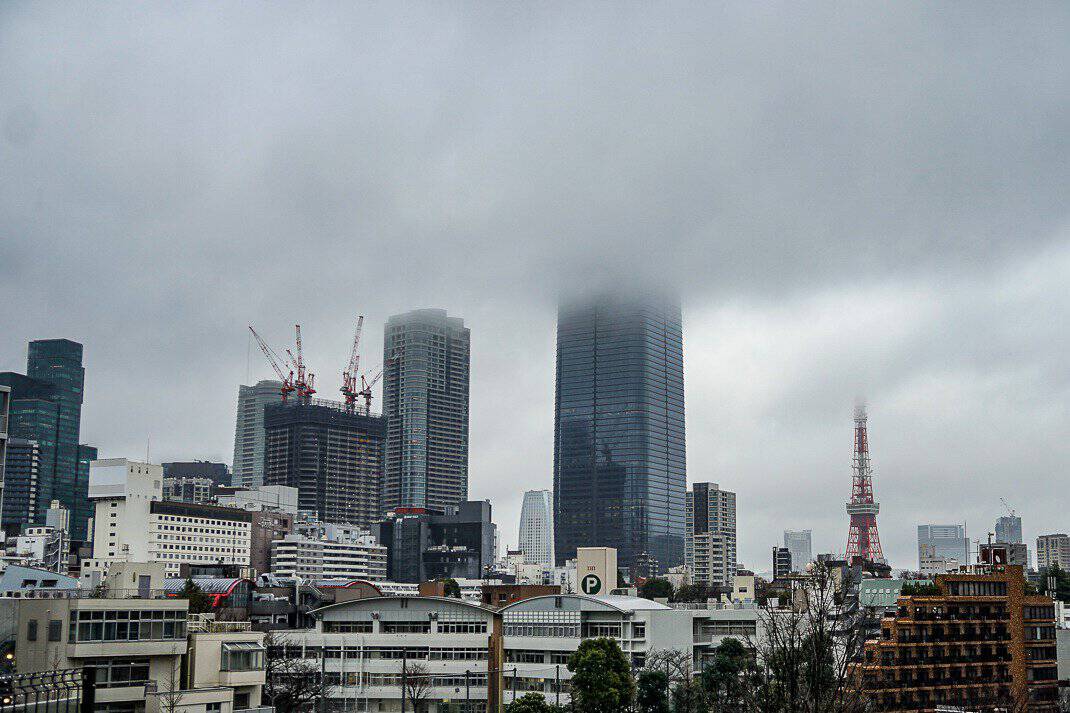
Not seeing the top through the rain and clouds as we entered the lobby was foreshadowing of what was to come. The kind clerk was honest. Don’t go up. You won’t see a thing.
The rest of our Tokyo sightseeing consisted of a rainy walk to the Imperial Palace that wasn’t worth more than this paragraph suggests. It commands a giant compound in the middle of Tokyo and includes one of the few patches of green in the city. Tokyo is so covered in concrete, from the top of Tokyo City View it must look like a parking lot sprinkled with a few green M&Ms. The only lawns are golf courses.
The Imperial Palace is built on the site of Edo-jo, the castle built in 1457 for Tokugawa, one of Japan’s most famous shoguns, commanders in chief during feudal Japan. At the time, it was the largest castle in the world. But today the only original part left is the moat and stone walls which are the only things we saw.
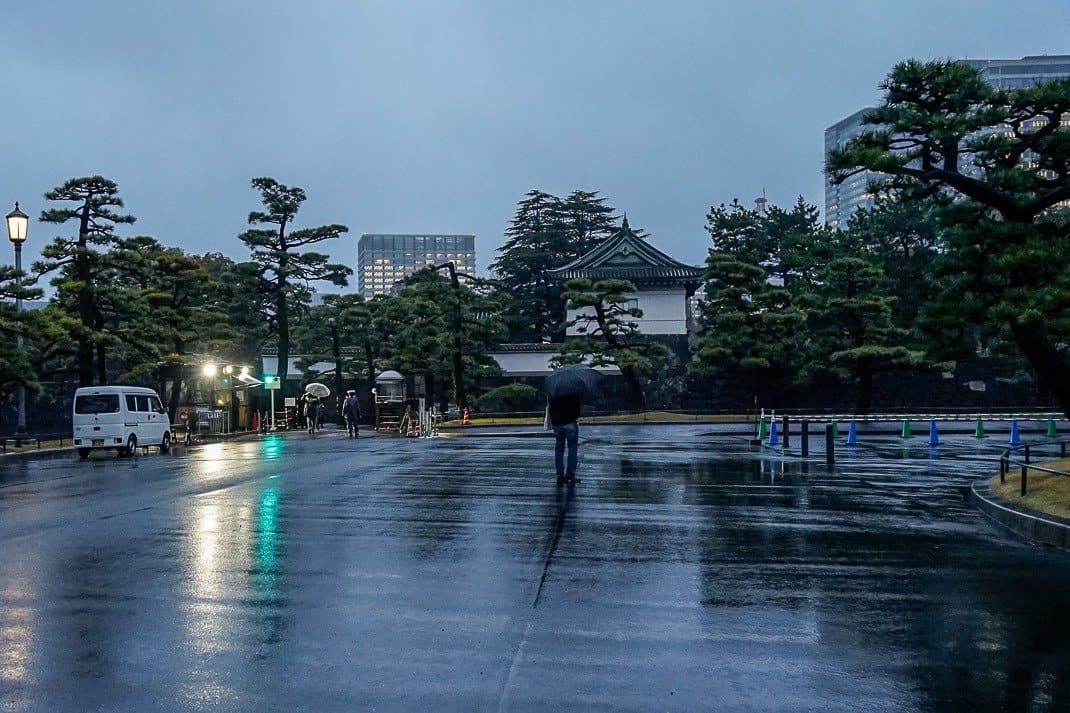
We arrived late. The sky had gone from gray to black. I approached the guard with my second umbrella turned inside out by the wind, the fate that landed my first umbrella in one of Tokyo’s few dumpsters. The city eliminated most of them after the gas attacks of 1995, leaving me puzzled how a city of 14 million and few trash cans is practically spotless.
The guard crossed his arms, the international symbol that it was closed. We didn’t argue. We were cold, tired and hungry. What we needed was soup and sushi. The disaster’s first day did give us some good news. It revealed a shocking surprise about Japan.
It’s cheap. Real cheap.
Japan costs
While I’ll blog about Japan’s food later, I will say the meals were cheaper than what we pay in Rome. They were cheaper than what we pay in Greece. They were nearly as cheap as what I paid in Montenegro.
It’s bad news for Japanese, good news for travelers. Last week, I received 167 yen for the euro. In 2019 I would have received 116. Consequently, we lived well in Japan. Lunches were €10-20 for two. Dinners €20-40. Our Tokyo hotel was a reasonable €105 a night.
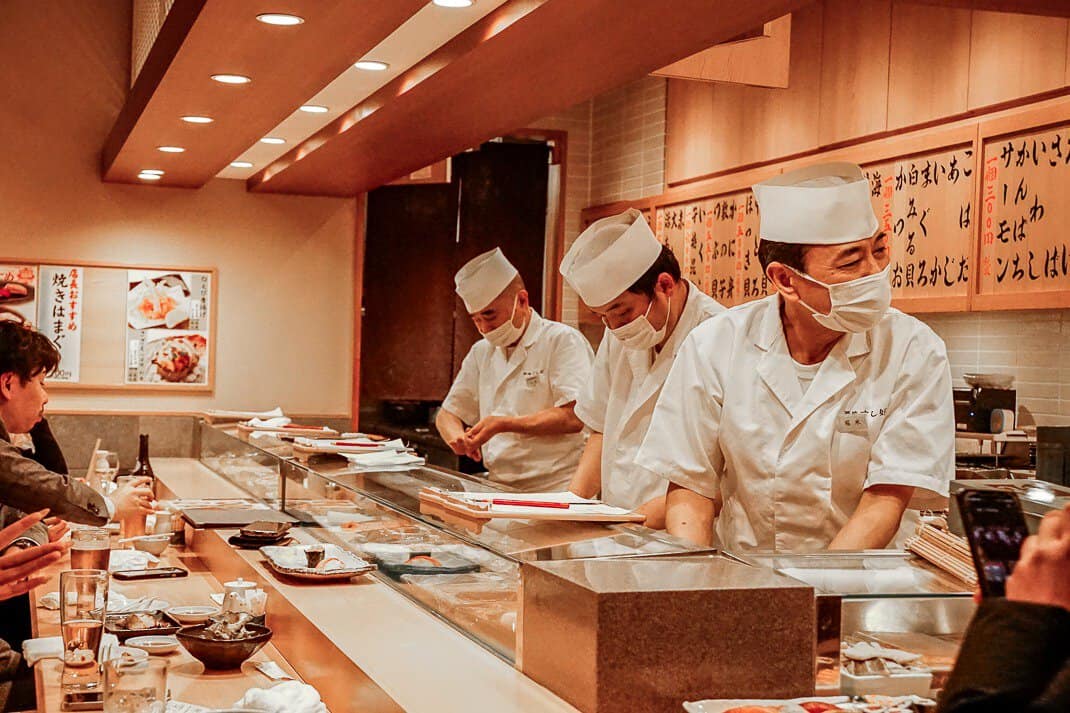
Who knew? I didn’t. I’d read that the Liberal Democratic Party, which has ruled Japan almost continually since it formed in 1955, is suffering through its highest disapproval rating in history. Scandal broke last fall with news that parliament members were receiving kickbacks from ticket sales to political fundraisers.
While Japanese are famous for being politically apathetic, they do care about an economy that has seen the yen drop by an annual rate of 20 percent since early 2022. Japan’s central bank has kept interest rates low to counteract inflation that has topped acceptable levels for two years and is at the same rate as the United States’.
In January, Japan’s economy dropped below Germany to fourth on the world list of nominal gross domestic product, the GDP without adjustment for inflation.
Japan’s population is also getting old with one in five people 75 and over. The population of 125 million is dropping by 1 percent a year and in the 2024 World Happiness Report, Japan ranked 51st. The U.S. was 23rd.
And standing in the rain coughing into a sky that covered the world’s biggest skyline in inky clouds, I wasn’t happy, either.
(Coming Friday: Shinkansen, Japan’s bullet train.)


April 3, 2024 @ 12:03 pm
Oh, John and Marina. Sorry to hear about the awful beginning of your trip to Japan! And that brew you were tippling for your welcome beer wasn’t even beer, but something called “happoshu” or “low-malt beer” – better referred to as “swill”! Looks like you really were dealt a losing hand! Let’s hope the rest of your adventure is an improvement.
Wishing you a speedy recovery and sunnier skies!
April 3, 2024 @ 12:44 pm
It wasn’t beer? It didn’t even have the decency to say non-alcoholic on it? Glad I only had one. No wonder it was half the price of Asahi.
April 3, 2024 @ 3:31 pm
Well, it is alcoholic, but Japan’s brewers made changes to the ingredients to create something akin to, but not quite, beer. Remember those “Tastes great, less filling” beer ads in the US back in your youth? This is Japan’s “Tastes awful, less expensive” alternative. Guess you’ll have to chalk it up as another unanticipated travel “experience” in the East! If it is still raining when you pull into Kyoto, at least you can check out some of the craft brews, or perhaps sake, to be found there.
April 4, 2024 @ 9:03 am
“Tastes awful, less expensive.” Great line. Wish I heard that before I wrote. It tasted not much different than Japan’s other shit industrial beers. I did have a craft beer in Kyoto, at €8 a pint, and it was quite good. I don’t think Tokyo is into craft beer. I did have sake and I’ve tried it in Japanese restaurants in the U.S. I’m not a big fan. You must either drink it very cold or warm. When it hits room temperature, it is absolutely ghastly.
April 3, 2024 @ 5:47 pm
What a start to a visit to one of the world’s great cities! So sorry about your cough. Brutal! But you’re right: the exchange rate is killer right now. I leave for Japan May 8 for three-weeks, my seventh trip, and never see everything I want to. Look forward to your next episode!
April 4, 2024 @ 9:01 am
Thanks, Deb. You’ll love the exchange rate. And it’s getting better by the day. The rate at the airport (167 yen per euro) was even better than what I got online before I left. My next trip to Japan will be more time in Tokyo and in Northern Japan. Heard great things about it.
April 3, 2024 @ 10:36 pm
Oh I am so sorry you even stopped in Tokyo. Next time fly to Osaka and go straight to one of the world’s best places, Kyoto. I look forward to your report on that marvelous host of over 3000 temples and shrines.
April 4, 2024 @ 8:59 am
Marina loved Tokyo. There’s a lot to see and do there. Why don’t you like it? We tried flying to Kyoto from Rome but flying to Tokyo was much cheaper, even after adding the bullet train. Afterward, Marina wish we’d spent three nights in Tokyo and three in Kyoto instead of two and four. Kyoto, as I wrote, had two of the worst tourist traps of my life: Fashimi and the Bamboo Forest. Mamma mia!
April 4, 2024 @ 8:53 am
I nearly died of the heat in Tokyo last September. I feel no need to return.
April 4, 2024 @ 8:57 am
I heard, Debra. Some sportswriting colleagues went to Tokyo for NFL exhibition games in August years ago. They nearly died, too. I prefer cold to heat.
April 5, 2024 @ 4:24 am
Well, the city resembling a set of Blade Runner has its appeal to me. Love Tokio.
April 5, 2024 @ 5:38 am
I need more than 36 hours in Tokyo. Marina already wants to return.
April 5, 2024 @ 8:33 am
Wow John, definitely NOT what you were expecting, as I sensed your excitement prior to departure. As an Oregonian, I’m confident you could’ve dealt with the rain, but a cough? Not so easy. You never really said if your cough was painful (Strep) or just annoying. Having to travel sick, in any form, is not pleasant. I really felt your pain and frustration as I kept reading. There’s no Japanese version of Vicks NyQuil/DayQuil? Sigh…….
Get better, and find better beer
April 7, 2024 @ 11:44 am
The cough wasn’t painful, just annoying. It’s annoying when I cough so much I can’t talk. But the pills I got in a pharmacy worked real well. What bothered me was looking for a cure took precious hours we didn’t have time to spare.